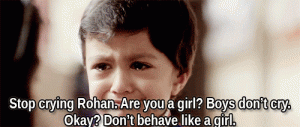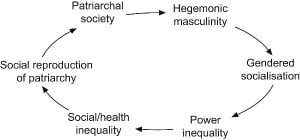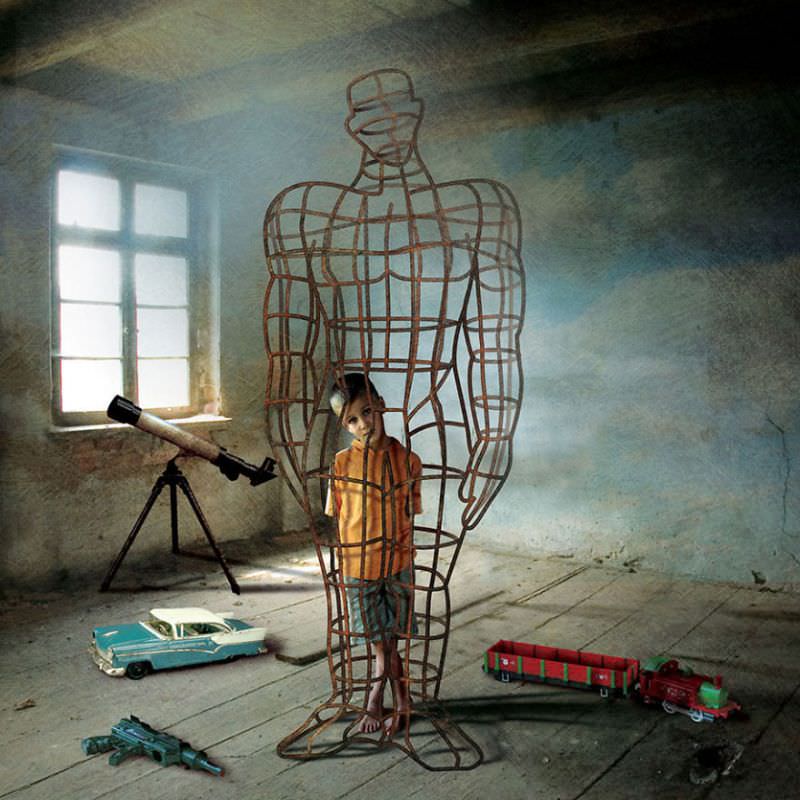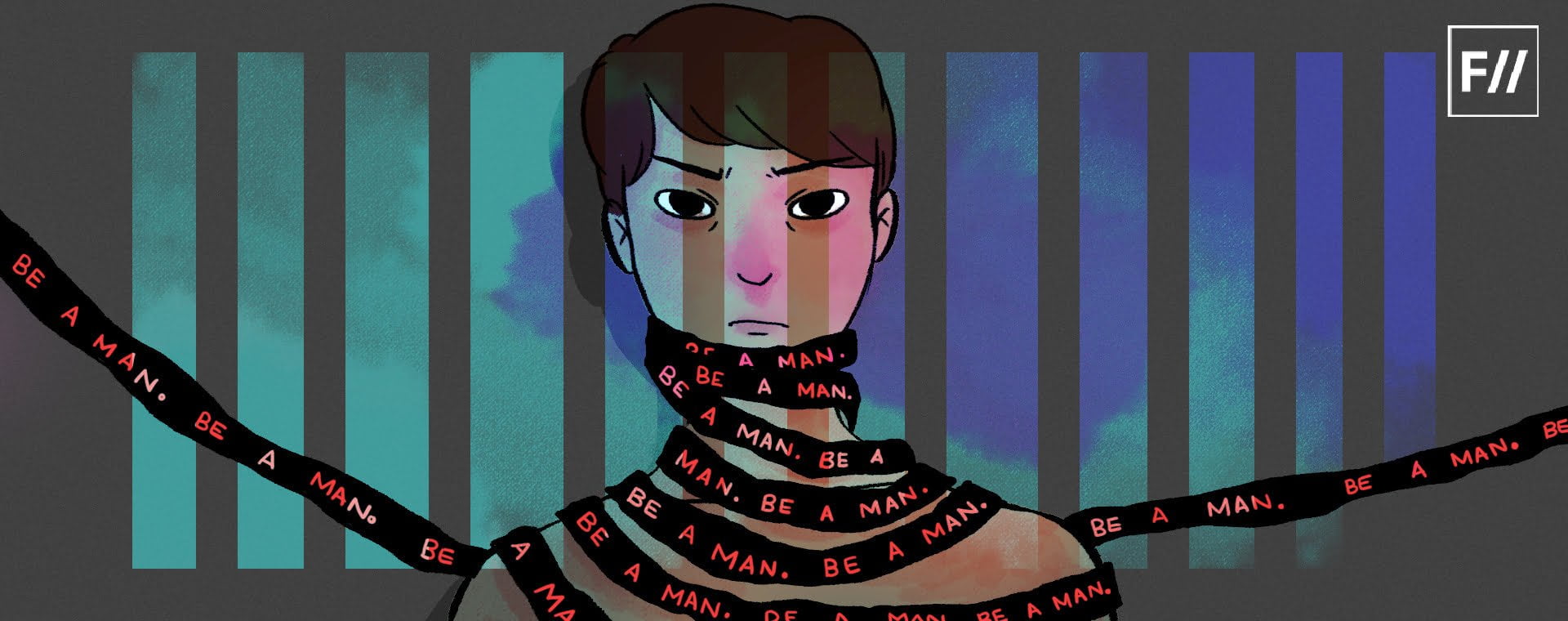Gender, in a society, translates to power. To understand a woman’s power pertaining to her gender, we must first understand a man’s. Without the proper understanding of masculinity, we can’t comprehend how patriarchy operates in it’s entirety. Masculinity plays a vital role in addressing and influencing gender biases and inequality. The patriarchy has not only victimised women but also men.
When asked about the qualities of a ‘real man‘, our minds promptly respond with words like leader, strong, dominant, authoritative, intelligent, confident, muscular, tall, tough, provider, dependable, fighter and so many more. Such is the concept of masculinity carved out by the society. But let’s stop and think for a moment. Do all the men in your life and around you, be it your father, brother, son, friend, teacher or neighbour, fit into this conventional idea of masculinity word for word?

(Image Credit: dailycayli.wordpress.com)
Men in my life don’t fit into the definition of these words. They might identify with some of the characteristics mentioned above, but not all. Are they not real men, then? They are very much real and very much a man, each with his individual sense of masculinity.
We, as a society, have created rigid conventions around masculinity and what a man should be. The consumption of this toxic masculinity is not done or preached only by men but by women as well. The ideals we assign to masculinity create a continuous need to fit in. The pressure to prove their masculinity at every given chance becomes immense on boys.
From a young age, the ideals of conventional masculinity shape the way boys look at themselves and at other men around them. It also shapes how girls look at the boys and men around them. Masculinity is introduced to young boys as if it were their biological identity and not their social identity which they learn and understand through their upbringing. This then enforces them and pressurises them into align with the conventional ideas of society. If they don’t, they are often ridiculed and punished until they do. It’s a straight line that the society makes every possible effort to not let anyone deviate from.
The Institution of Family and Masculinity
Introductory lessons to masculinity begin at home for young boys, which is often defined by conventions. Within the dimensions of a family, both boys and girls learn the behaviours and mannerisms assigned to each sex. The concept of male honour and the privilege and entitlement that comes along with it are fed allusively to them. Thus, it becomes the root of the problem.
Living in the same house as my three nephews and one niece taught me the ignorant ways in which we ourselves sensitise our children, often with faulty notions. From as trivial as choosing colours or gifts for them to as significant as choosing subjects to study, we impress upon them the gendered beliefs we carry.
Reluctantly, I now look back upon a time when my family and I bought the boys every colour but pink or purple. How benighted had I been to not be able to grasp the simplest of concepts that colours don’t have genders. Inevitably, it concluded with their aversion to colours pink and purple for they are ‘girlie‘ and undertaking of a prolonged journey for their parents and myself to dispel the belief.

Gendered colour coding starts from an early age (Image Credit: jeongmeeyoon.com)
Also read: Monster Trucks for Boys and Tiaras for Girls: Pointlessly Gendered Products
And then, it continued; if not by us, then by someone else; if not about colours, then about something else. My nephews were taught how to make simple snacks in school sometimes. Once he proudly displayed his cooking to a guest we were entertaining and the response he received was ‘cooking toh girls karti hai’ (cooking is done by girls). One of my nephews loves to dance and so, naturally, his parents made him join a dance class, a decision which often met with the uninvited critiques about how dancing was for girls, not boys.
These are only a few of the many ways in which we sensitise young boys, perhaps ones that have less severe impacts on their mindsets and self-image. More toxic are the concepts of strength and toughness we attach with masculinity.
Phrases like ‘Mard ko dard nhi hota’ (men don’t feel pain), ‘Mard ban, mard’ (man up!) and ‘Ladke rote nhi hai’ (boys don’t cry) do more harm to boys and men than we can discern. Every time we tell a young boy to not cry simply because he is a boy, we train him to disregard his emotions. Crying is considered a weakness, something a real man mustn’t ever possess. It creates a reluctance in him to even address his emotions, replacing it with aggression instead.
Also read: BOYS DON’T CRY: The gender guidelines and empowerment efforts

A popular TV advertisement portraying norms on masculinity (Image Credit: rebloggy.com)
This concept is built upon the notion that it strengthens boys, but in reality, we are only weakening them. Imagine the helplessness a boy or a man must feel at not being able to do as little as express himself. Why? Because masculinity! Because he ought to fit into the typecast definition of a real man lest he be an outcast.
And then there’s the whole other dimension of meanings these phrases attach to a boy’s understanding of acceptable gendered characteristics and his self-image. ‘Mard ko dard nahi hota’ and ‘Ladke rote nahi hai’ insinuate that only girls and women feel pain and cry and hence show weakness, thus developing the understanding of women as a weaker sex in a boy’s mind.
I first came across this reluctance to talk about emotions and accept getting hurt as not something exclusive which only happens to girls, in my eight-year-old nephew, when, I gifted him Let’s Talk About Getting Hurt by Joy Berry and Maggie Smith. The reason for giving him the book was that he frequently throws tantrums and since the book helps children understand the normal fear of getting hurt, I thought that it might help.
Upon being asked if he had read the book, my nephew responded with a no, saying, ‘It’s a girls book.’ Why? Because it talked about getting hurt throughout. The answer took me by an unpleasant surprise, it shouldn’t have though. It didn’t matter that, he had been crying just an hour back, and when confronted about getting hurt, the eight-year-old knew it was a concept unrelated to his gender. Turns out, he learnt it from his peers that boys aren’t supposed to cry. Cue a long and desperate explanation of how crying and getting hurt isn’t a bad thing and it’s okay to do them, even if you’re a boy.

Gendered segregation of toys for boys and girls (Image Credit: brainpickings.org)
Within a family, a boy learns the relationship between gender and space, meaning who belongs where: mother in the kitchen and father in the office, sister with dolls and brother with trucks. The bringing up of a boy plays a crucial role in forming his understanding of the social constructs around masculinity, hence impacting the way he sees and conducts himself.
The Institution of School and Masculinity
School acts as an institution to reinforce the traditional social constructs that the institution of family has already planted in the young minds or to change the ones that somehow ended up diverging.
Within a school, children get to interact with other children who come from different families, bearing different mindsets. Even if somehow one set of parents manage to construct a better perception of masculinity and gender roles in a boy’s mind, they can’t control what other children are being taught at their homes. Children with whom interaction and their subsequent influence will be unavoidable. School, therefore, becomes the second place where boys learn about masculinity and perhaps becomes more pivotal than family, as peer persuasion is often more impressionable.
Also Read: 11 Ways How Toxic Masculinity Hurts Men
Schools establish masculinity in a dominant heterosexual context. The school set-up is structured to minimise the anxiety regarding the gender identities by enforcing the ‘proper‘ way of being and behaving. It augments the idea of hegemonic masculinity by normalising it while labelling any other kind as unacceptable. This increases the pressure on boys to conform.

Gendered career choices for boys and girls (Image Credit: brainpickings.org)
In school, boys learn about the ‘ideal men‘, men who should inspire them. Boys get their role models in school from amongst the many celebrated men they learn about. For instance, even if a young boy enjoys painting or cooking, when asked what will he be in the future, his prompt answer is either a scientist, or a firefighter, or a pilot, or a doctor. Simply because these are the professions advertised to him in schools, something that obeys the rules of traditional masculinity and upholds the ideals of intelligence and strength that a man must possess.
Treading in the same line of thought, we often find the concept of masculinity interfering with the preference of education as well. A boy intending to take the humanities stream is criticised and persuaded to lean towards commerce or science, for they are the streams wherein his career lies. The careers that fall in line with what his masculinity should be. Masculinity for young boys, therefore, becomes inflexible and attempts to shape them within the presumed mould of masculinity.
Furthermore, the school also becomes the ground for comparison between masculinities of different boys. Boys struggle continually to prove their masculinities by displaying their strengths over other boys and the physical strength becomes the deciding factor. The strongest one becomes the most masculine and most admirable.
School again reinforces the idea of women as a weaker sex since it also becomes the ground for comparison between the male and female. In most schools, boys and girls are made to play different sports or in different teams. When I was in school, our physical education teacher provided boys with basket balls and volleyballs while girls were suggested to play Kho-Kho or Badminton.
However, when boys and girls do end up playing together, and god forbid the boy loses to a girl, there is no end to the jibes of ‘lalat hai tere pe, ladki se haar gaya’ (shame on you, you lost to a girl!). It directly attacks the masculinity he worked so hard to build, the fragility of which comes to the surface by the simple act of loosing in a sport to a girl.

(Image Credit: gacetasanitaria.org)
Social institutions influence the mindsets of boys while they are young, in order to limit them to the rigid moulds of mainstream masculinity. As they grow up, this mould is further strengthened and seldom changes. This kind of masculinity aims at producing only one kind of a man while disregarding anyone who doesn’t fit in and hence, becomes toxic for men. Patriarchy heavily depends on hegemonic masculinity to keep it’s unbending control over the society and it’s women. Till we are unable to change the conventional perceptions around masculinity, fighting patriarchy would be a lost cause.
Also Read: How Patriarchy Hurts Men Too
From the Author: This article draws several inputs from the National Civil Society Workshop on Masculinities and Gender Justice organised by Centre for Health and Social Justice on 26th and 27th May 2017.
Featured Image Credit: Polish artist Igor Morski
About the author(s)
Shagun Gupta is a fiction enthusiast and an amateur photographer, currently embarking on a writing career after having recently earned her post-graduate degree in Mass Communication.





Loses not looses. Otherwise a great article.
Mostly nonsense. Boys and consequently men have 10 times the testosterone as women. So some qualities in men like strength, aggressiveness, energy, dominance are not “society expectations” as you so naively put it. These are the result of thousands of years of evolution and selective breeding. Women sought out men with these characteristics because that’s what was essential for survival.
Even today, while so called equality seeking feminists demand equal representation in parliament and boardroom, they seem to not want equality in jobs in mining, deep sea fishing, construction workers etc. Wonder why? Because the former jobs are in a relatively safe environment and the latter need masculine characteristics.